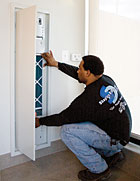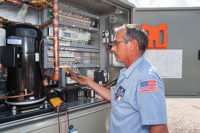
Taking advantage of thermal energy and internal heat gains, contractors find a way to harness cast-off thermal energy and use it for multiple heating purposes. (Feature photos courtesy of ClimateMaster.)
No longer considered endless, Earth’s limited resources and changing atmospheric conditions are pushing global changes in energy usage, especially in the HVACR industry. Renewable energy sources are now being developed at a greater pace than was anticipated just a few years ago, and one of the fastest growing trends in the commercial building industry is the use of water-source heat pumps for heating and cooling.
“Water-loop technology has been around for decades, though now - pushed by rising energy costs and the call to arms by the USGBC [United States Green Building Council] and the advantages of LEED [Leadership in Energy and Environmental Design] certification - interest in the technology is gaining rapidly,” said John Bailey, vice president of sales and marketing for Oklahoma City-based ClimateMaster Inc. “We refer to the water-loop process as ‘thermal energy transfer.’”
THERMAL ENERGY TRANSFER
Water-source heat pump or thermal energy transfer (TET) systems provide highly efficient zone-controlled heating and cooling throughout a building by circulating water in a closed piping loop that moves and exchanges thermal energy. With such technology, a building has within it many separate heat pumps connected by closed-system water loops. These transfer thermal energy with great efficiency.Individual heat pumps add or remove heat from the air within each zone as required to meet its unique heating or cooling load. During zone heating, they extract needed heat (thermal energy) from the common water loop. During zone cooling, heat is rejected into the water loop where it can then be shared with all other heat pumps throughout the building. It’s in this way that rejected heat - which in most systems is wasted to the outdoors - is fully utilized before any new energy source is used to heat or cool the building.
Water-source heat pumps use a simple vapor compression refrigerant circuit to efficiently provide zone heating or cooling. During the cooling mode, heat is extracted from the air and rejected into the water loop. During the heating mode, the process is reversed, with heat being extracted from the water loop and rejected into the air. Thus, thermal energy is transferred, or pumped, between the air and the water loop, in either direction, on demand.

Three modulating-condensing Laars Rheos-plus boilers provide supplemental heat for a thermal energy transfer system.
Bailey explained that all buildings contain year-round sources of thermal energy, or internal heat gains that are recovered and recycled by TET systems, such as lighting, people, equipment, and solar gain. Perimeter zones may require daytime cooling, even during cold weather.
The cast-off thermal energy within the building envelope recovered in the water loop of a water-source heat pump system can be used for most purposes that require heat, such as:
• Space heating: Water-source heat pumps in zones that require heating will extract thermal energy from the water loop.
• Water heating: Water-to-water heat pumps can be equipped to extract thermal energy from the water loop to heat domestic hot water, swimming pools and spas, or to serve hydronic loads such as radiant heat or snow-melt systems.
• Ventilation:Dedicated outside-air heat pumps extract thermal energy from the water loop to heat outside air used for ventilation.

A ClimateMaster water-to-water heat pump is commissioned at Midtown Exchange in Minneapolis by mechanical contracting firm Horwitz NSI.
WHY WATER?
Water is arguably the most efficient way to move thermal energy. A 2-inch water pipe can carry the same amount of cooling as a 24-inch air duct, requiring up to 90 percent less transport energy in the process. The mass of the water loop also provides thermal storage, allowing a substantial amount of heat to be carried from occupied periods into morning warm-up. This thermal storage is not a capability found with traditional systems.The newest generation of water-source heat pump heating and cooling technology for large buildings has pushed operational efficiencies into the 500-600 percent range. In essence, for every unit of energy used to operate the equipment, the system delivers five to six units of energy in return. This along with sophisticated controls, system integration with building automation systems, and supplemental energy sources help contribute to how quickly the commercial building market is evolving.

This boiler provides back-up heat for an ultra-high-efficiency hydronic system in California.
Heat pumps, which have the potential for off-the-charts efficiency performance, are beginning to garner building owners’ attention. When the design engineer can calculate a three- to four-year payback for new equipment, or perhaps even shorter than that in some instances, it can provide building owners real incentive to install new technology. Not only for new construction, many of these systems are also ideal for retrofit application.
“The industry’s changing,” noted Bailey. “And the market for this new technology is growing quickly. The technology continues to improve steadily, and yet a large number of building owners still haven’t heard the news.”

Troubleshooting and maintenance are important to maintain the modulating-condensing boilers that provide supplemental heat for a thermal energy transfer system.
Water-loop heat pump systems combine water-source heat pumps on a common piping loop with a heat rejector and boiler, which are used to maintain the circulating water temperature within a controlled range, typically from 60° to 95°F. The most common heat rejectors are open cooling towers with isolating heat exchangers, closed-circuit evaporative coolers, or dry coolers.
Water-to-water heat pump systems also operate very efficiently under part-load conditions, such as when a small portion of the building remains occupied after hours.

All key parts for replacing a filter for a “vertical stack” water-sourced heat pump unit are accessible within the living or public space.
The advantages of water-to-water systems include year-round individual control, energy savings, tenant metering, quiet operation, low initial cost, maximized space, minimized downtime, simple control, and simple commissioning and maintenance.
Recent advancements also include the use of zero ozone-depleting HFC-410A refrigerant, further enhancing the operational efficiency of water-to-water heat pumps. Some units use 100 percent outside air. Other sophisticated systems offer a dehumidification option, allowing designers even greater flexibility when meeting more stringent building requirements.
Publication date:05/24/2010



